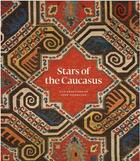-
Date de parution : 12/01/2024
-
Editeur :
Paul Holberton
-
EAN : 9781913645588
-
Série :
(-)
-
Support :
Papier
Résumé:
This illuminating exhibition catalogue interrogates the entanglement of the Islamic world with European visual culture during the medieval period and Renaissance, from the 9th century to the end of the 17th. It traces and reveals this interconnectedness through works of art that reflect the... Voir plus
This illuminating exhibition catalogue interrogates the entanglement of the Islamic world with European visual culture during the medieval period and Renaissance, from the 9th century to the end of the 17th. It traces and reveals this interconnectedness through works of art that reflect the intense environment of contact, influence and exchange which developed over centuries between the two cultures. It also explores the reception of the image of 'Islam' in Europe, as highlighted by an important painting of the Supper at Emmaus, painted in the so-called 'Oriental Mode' by the Venetian artist Giovanni Mansueti (c. 1465-1527) in the last decade of the 15th century.
Islam in Europe presents a survey of artistic production in the medieval Islamic world and the many ways it altered the trajectory of European visual culture. Opening with early�medieval objects produced by Muslim artisans and known to have been exported in large numbers to medieval Europe, the catalogue explores the crosscurrents of visual culture at the nexus of Islam and Christendom which were already well developed by the 10th century. It continues with artworks produced under the aegis of the Umayyads (711-1031) and later Islamic dynasties which ruled large swathes of the Iberian Peninsula until 1492, and the influence of Islamic rule on the development of a distinctive visual culture in medieval Spain.
A central group of objects traces the breathtaking force with which refined export wares from Mamluk Egypt and Syria, Central Asia and Anatolia flooded the Italian market during the 14th to 16th centuries, revolutionizing European aesthetics as well as the taste for (and very definition of) luxury goods. This section of the catalogue includes objects that chart the rise of European textiles, metalwork, ceramics and other arts specifically emulating Islamic designs.
Donner votre avis















